
- Services for education institutions
- Academic subject areas
- Peer connection
- Evidence of Studiosity impact
- Case studies from our partners
- Research Hub
- The Tracey Bretag Integrity Prize
- The Studiosity Symposium
- Studiosity for English learners
- Video case studies
- Meet the online team

Academic Advisory Board
Meet the board.
- Social responsibility
- Meet the team
- Join the team

How to structure paragraphs using the PEEL method
Sophia Gardner
Sep 1, 2023
You may have heard of the acronym PEEL for essays, but what exactly does it mean? And how can it help you? We’re here to explain it all, plus give you some tips on how to nail your next essay.
There’s certainly an art to writing essays. If you haven’t written one for a while, or if you would like to hone your academic writing skills, the PEEL paragraph method is an easy way to get your point across in a clear and concise way, that is easily digestible to the reader.
So, what exactly is PEEL ?

The PEEL paragraph method is a technique used in writing to help structure paragraphs in a way that presents a single clear and focused argument, which links back to the essay topic or thesis statement.
It’s good practice to dedicate each paragraph to one aspect of your argument, and the PEEL structure simplifies this for you.
It allows you to create a paragraph that is easy and accessible for others to understand. Remember, when you’re writing something, it’s not just you who is reading it - you need to consider the reader and how they are going to be digesting this new information.
What does PEEL stand for?
P = Point: start your paragraph with a clear topic sentence that establishes what your paragraph is going to be about. Your point should support your essay argument or thesis statement.
E = Evidence/Example: here you should use a piece of evidence or an example that helps to reaffirm your initial point and develop the argument.
E = Explain: next you need to explain exactly how your evidence/example supports your point, giving further information to ensure that your reader understands its relevance.
L = Link: to finish the paragraph off, you need to link the point you’ve just made back to your essay question, topic, or thesis.
Download a free PEEL paragraph planner below. 👇

Studiosity English specialist Ellen, says says students often underestimate the importance of a well-structured paragraph.
PEEL in practice
Here’s an example of what you might include in a PEEL structured paragraph:
Topic: Should infants be given iPads? Thesis/argument: Infants should not be given iPads.
Point : Infants should not be given iPads, because studies show children under two can face developmental delays if they are exposed to too much screen time.
Evidence/Example: A recent paediatric study showed that infants who are exposed to too much screen time may experience delays in speech development.
Explanation: The reason infants are facing these delays is because screen time is replacing other key developmental activities.
Link: The evidence suggests that infants who have a lot of screen time experience negative consequences in their speech development, and therefore they should not be exposed to iPads at such a young age.
Once you’ve written your PEEL paragraph, do a checklist to ensure you have covered off all four elements of the PEEL structure. Your point should be a clear introduction to the argument you are making in this paragraph; your example or evidence should be strong and relevant (ask yourself, have you chosen the best example?); your explanation should be demonstrate why your evidence is important and how it conveys meaning; and your link should summarise the point you’ve just made and link back to the broader essay argument or topic.

Keep your paragraphs clear, focused, and not too long. If you find your paragraphs are getting lengthy, take a look at how you could split them into multiple paragraphs, and ensure you’re creating a new paragraph for each new idea you introduce to the essay.
Finally, it’s important to always proofread your paragraph. Read it once, twice, and then read it again. Check your paragraph for spelling, grammar, language and sentence flow. A good way to do this is to read it aloud to yourself, and if it sounds clunky or unclear, consider rewriting it.
That’s it! We hope this helps explain the PEEL method and how it can help you with your next essay. 😊
You might also like: Proofreading vs editing: what's the difference? How to get easy marks in an exam 5 study hacks that actually work
Topics: English , Writing , Grammar
About Studiosity
Asking for feedback on your work is an essential part of learning. So when you want to better understand a concept or check you're on the right track, we're here for you.
Find out if you have free access through your institution here .
Recent Posts
Posts by topic.
- Students (85)
- Higher education (69)
- Student Experience (48)
- University (47)
- Education (42)
- online study (34)
- Interview (29)
- Learning (28)
- Tertiary education (28)
- Educators (27)
- Research (25)
- Parents (23)
- English (18)
- High School (18)
- Podcast (18)
- students first (18)
- Technology (17)
- Writing (17)
- Student stories (14)
- Homework (13)
- student wellbeing (13)
- Assignment Help (12)
- Education policy (12)
- Formative feedback (12)
- Literacy (12)
- academic integrity (12)
- Academic Advisory Board (11)
- Events (11)
- Learning trends (10)
- Student satisfaction (10)
- Studiosity (10)
- covid19 (10)
- international student (10)
- Australia (9)
- Health and Wellbeing (9)
- Teaching (9)
- Equality (8)
- Secondary education (8)
- Science (7)
- Student retention (7)
- UK students (7)
- staff wellbeing (7)
- Partnerships (6)
- Student support (6)
- UK Higher Education (6)
- academic services (6)
- online learning (6)
- CanHigherEd (5)
- Online Tutoring (5)
- Student performance (5)
- Workload (5)
- belonging (5)
- CVs and cover letters (4)
- Internet (4)
- Mathematics (4)
- School holidays (4)
- Widening Participation (4)
- student success (4)
- #InthisTogether (3)
- Grammar (3)
- University of Exeter (3)
- generativeAI (3)
- teaching & learning (3)
- Charity (2)
- Government (2)
- Mentors (2)
- Primary education (2)
- Subject Specialists (2)
- academic writing (2)
- accessibility (2)
- community (2)
- diversity (2)
- plagiarism prevention (2)
- student stress (2)
- webinar (2)
- Biology (1)
- Careers (1)
- Chemistry (1)
- EU students (1)
- First Nations success (1)
- First years (1)
- Indigenous Strategy (1)
- Middle East (1)
- Nutrition (1)
- Teacher (1)
- academic support (1)
- business schools (1)
- choice of language (1)
- dyslexia (1)
- ethical AI (1)
- job help (1)
- library services (1)
- podcasts (1)
- reflection (1)
- university of west of england (1)
- July 2015 (12)
- March 2020 (11)
- June 2020 (10)
- July 2020 (8)
- September 2020 (8)
- March 2015 (7)
- April 2015 (7)
- October 2019 (7)
- April 2020 (7)
- May 2018 (6)
- April 2019 (6)
- May 2020 (6)
- September 2022 (6)
- October 2024 (6)
- June 2015 (5)
- August 2015 (5)
- December 2017 (5)
- March 2018 (5)
- February 2020 (5)
- March 2021 (5)
- June 2021 (5)
- July 2016 (4)
- March 2017 (4)
- February 2018 (4)
- August 2018 (4)
- May 2019 (4)
- July 2019 (4)
- August 2019 (4)
- March 2024 (4)
- August 2024 (4)
- February 2015 (3)
- May 2015 (3)
- September 2015 (3)
- December 2015 (3)
- January 2016 (3)
- April 2016 (3)
- October 2016 (3)
- December 2016 (3)
- April 2017 (3)
- September 2017 (3)
- October 2017 (3)
- April 2018 (3)
- October 2018 (3)
- March 2019 (3)
- January 2020 (3)
- October 2020 (3)
- November 2020 (3)
- June 2022 (3)
- October 2022 (3)
- November 2022 (3)
- February 2023 (3)
- August 2023 (3)
- November 2023 (3)
- April 2024 (3)
- July 2024 (3)
- March 2016 (2)
- May 2016 (2)
- August 2016 (2)
- July 2017 (2)
- January 2018 (2)
- November 2018 (2)
- December 2018 (2)
- February 2019 (2)
- June 2019 (2)
- September 2019 (2)
- January 2021 (2)
- February 2021 (2)
- April 2021 (2)
- August 2021 (2)
- September 2021 (2)
- December 2021 (2)
- August 2022 (2)
- March 2023 (2)
- May 2023 (2)
- December 2023 (2)
- June 2024 (2)
- September 2024 (2)
- October 2008 (1)
- August 2013 (1)
- October 2015 (1)
- February 2016 (1)
- June 2016 (1)
- September 2016 (1)
- November 2016 (1)
- January 2017 (1)
- May 2017 (1)
- June 2017 (1)
- August 2017 (1)
- November 2017 (1)
- June 2018 (1)
- September 2018 (1)
- January 2019 (1)
- November 2019 (1)
- December 2019 (1)
- August 2020 (1)
- December 2020 (1)
- May 2021 (1)
- February 2022 (1)
- March 2022 (1)
- July 2022 (1)
- December 2022 (1)
- January 2023 (1)
- June 2023 (1)
- July 2023 (1)
- September 2023 (1)
- October 2023 (1)
- February 2024 (1)
- November 2024 (1)
Studiosity is personalised study help, anytime, anywhere. We partner with institutions to extend their core academic skills support online with timely, after-hours help for all their students, at scale - regardless of their background, study mode or location.
Now you can subscribe to our educator newsletter, for insights and free downloads straight to your inbox:

ABN 41 114 279 668
Student zone, assignment calculator, calendars and organisers, study survival guides, free practice tests, student faqs, download our mobile app, student sign in, success stories.
Student Reviews & Testimonials
Specialist Sign In
Meet our specialists
Meet the team, media and research, student reviews.
Read more on Google
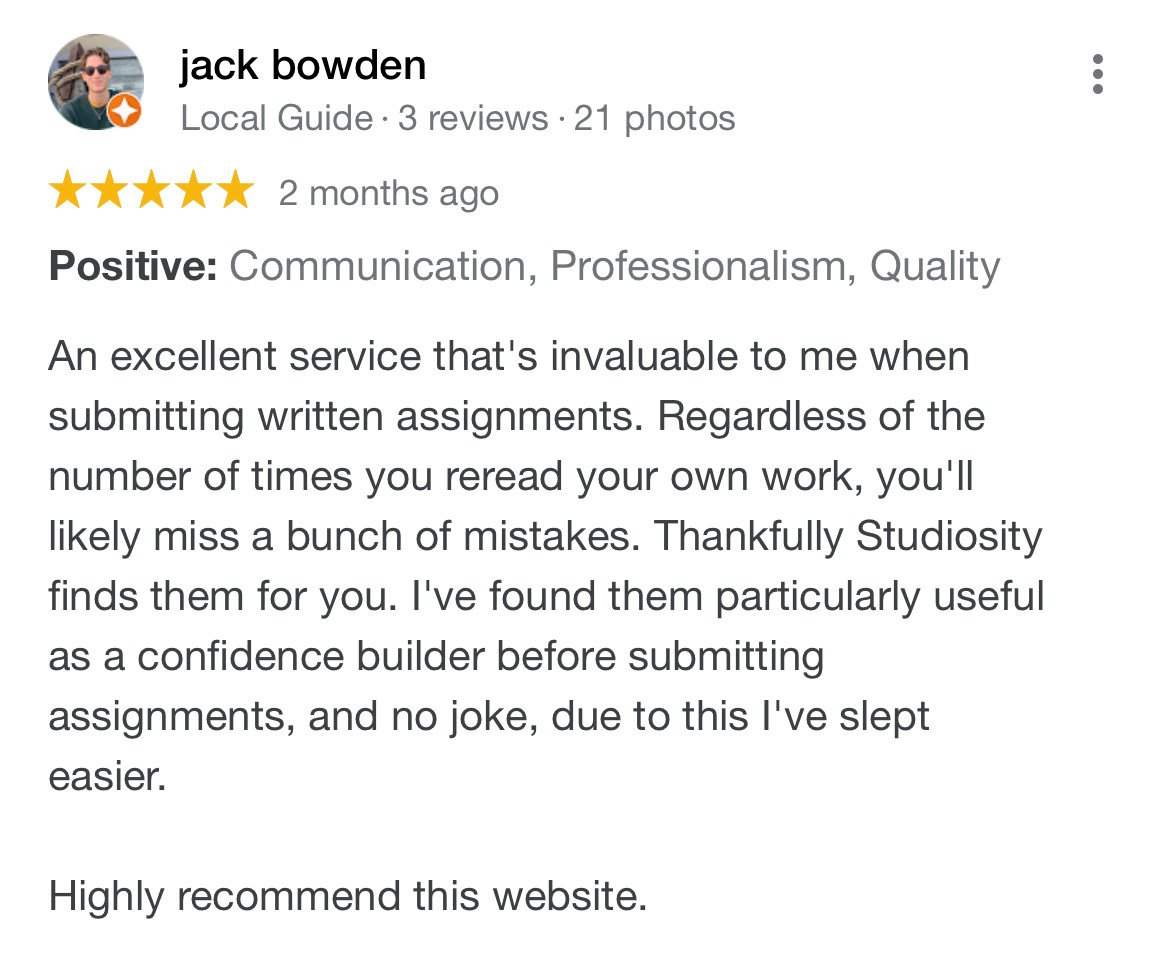
Studiosity acknowledges the Traditional Indigenous Custodians of country throughout Australia, and all lands where we work, and recognises their continuing connection to land, waters, and culture. We pay our respects to Elders past and present.
Contact • FAQ • Privacy • Accessibility • Acceptable Use • Terms of Use AI-for-Learning Polic y • Academic Integrity Policy
- Have your assignments done by seasoned writers. 24/7
- Contact us:
- +1 (213) 221-0069
- [email protected]

How to Write a PEEL Paragraph Essay: With Examples
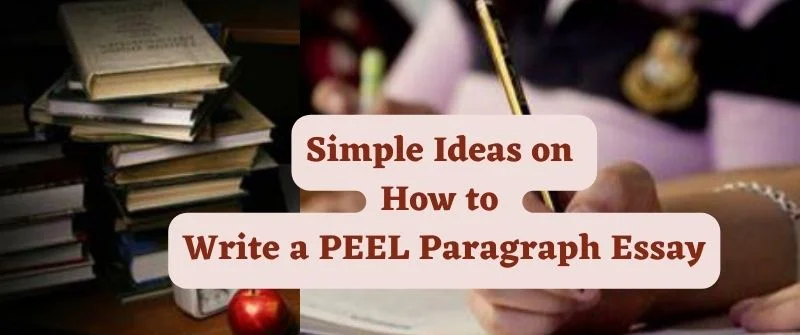
Writing a PEEL Paragraph Essay
A PEEL paragraph essay is one of the most vital elements in academic writing. The purpose and structure of a Peel essay are quite similar to an academic essay but with a major difference: instead of writing about a topic, you are required to come up with your original concept and then develop this idea from different angles, thus creating a well-rounded piece.
Also Read: How to Write a Discussion Essay for University: How to Start

What is a Peel Paragraph?
What is a peel (Point, Example, Explain, and Link) paragraph? The peel is a technique writers use to highlight a specific point in their writing.
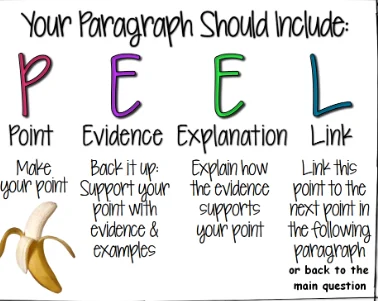
The peel paragraph is used in many types of writing, including essays, research papers, and literature reviews.
A peel paragraph is a paragraph that pulls the reader in and keeps them reading. It can be used to warm up a cold introduction or the last paragraph of your essay. A peel paragraph is a great way to end your essay on a high note, but that doesn’t mean you should just tack on a few extra words at the end and call it done.
The idea behind a peel paragraph is that you want to draw attention to something specific in your opening or closing lines. You want those lines to grab readers’ attention and make them want to read more about what you have to say. When writing an effective peel paragraph:
The peel is a device writers can use to highlight a particular idea or section of their essay. There are three types of peels:
- Point Peel: This type of peel highlights one main point of the essay. It is usually placed at the beginning or end of an essay and includes specific details about the topic as well as supporting evidence from the body paragraphs.
- Example Peel: This type of peel includes an example from an outside source that illustrates the main point in your essay. This type of peel works best when you want to emphasize your arguments by using real-life examples or situations.
- Link Peel: This type of peel connects one idea in your essay with another idea or section by providing links between them. This kind of peel should be used when you want to connect ideas so they are easier.
Also Read: Essay Reading: Practice and Importance of Reading Essays
How to write a Peel Paragraph
1. identify your point.
The first step in writing a peel paragraph is to identify your point. What is the main argument you want to make? This can be tricky because your reader may not agree with you. The important thing is to take their objections seriously and address them head-on.
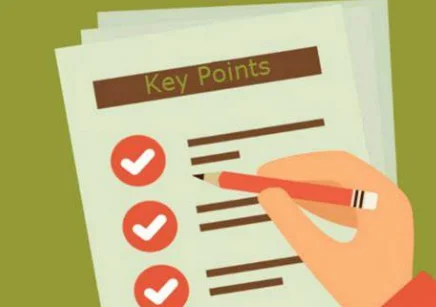
For example, suppose I want to write an article about why people should eat fewer fast food meals. My main argument is that getting fat and unhealthy leads to physical problems such as diabetes and heart disease, which are expensive to treat.
But some people might object that not all fat people have serious health problems or that excessive eating doesn’t necessarily cause health problems.
In this case, my job is to convince readers of the truth of my claim and its importance. They might stop reading right there if they think it’s silly or irrelevant!
Understand what makes your point important before you write it. Your main points are usually related directly to your topic sentence, but they shouldn’t be wordy or boring — they should be clear and concise.
Include as many details as possible when describing your point. Don’t just tell people your point; show them exactly how it works!
For example, if you’re writing about how government policy affects citizens’ lives, including specific examples from personal experience or research done by other experts in the field.
2. Incorporate your Example
Peel paragraphs are those that begin with an example, usually from the content of your article. They can introduce a new idea or show how you’ve applied something in practice.
The example should be clear and specific, so the reader understands exactly what you’re talking about. It shouldn’t be too complex, though, because this will make it harder for readers to understand what you mean.
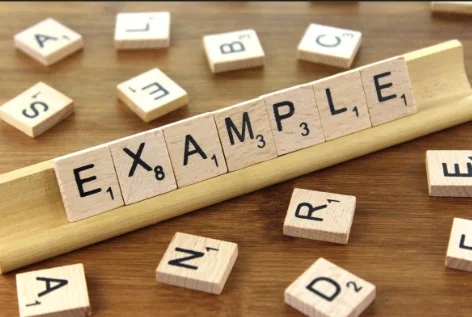
You can use a quote from someone else as an example if you don’t have time to write one yourself. Include their name at the beginning of your paragraph and give them credit for their words (or even the full quote) in your introduction.
3. Explain how your Example Supports your Point
To create a peel paragraph, you must explain how your example supports your point. This is called “transforming the example” or “building support.”
You can do this by:
- Pointing out that the example illustrates your point. For example, if you argue that “a little learning is a dangerous thing,” show how someone who gains knowledge quickly becomes arrogant and foolish.
- Explain why the example supports your argument. For example, if you are arguing that “a little learning is a dangerous thing,” show how someone who gains knowledge quickly becomes arrogant and foolish.
If you are talking about how college students are not doing enough to prepare for the job market after school, you might say:
There’s a difference between knowledge and skill. The vast majority of students don’t apply what they learn in college to the real world after they graduate. Instead of developing valuable skills, they spend most of their time playing video games or watching TV.
This example shows an imbalance between knowledge and skill in our society today. It also explains why this imbalance exists and what it means for people who have been educated on how to write a peel paragraph.
4. Finish off with your Link
When you’ve finished your paragraph, it is time to finish it with your link. This is the most important part of the whole article, and if you do not include this in your writing, it will be difficult for readers to find your page and read more about what you have written.

As well as providing a link back to your site, there are some other things you need to include with it:
- It should be short and simple but also informative and interesting for readers.
- It should not contain any advertisements or links to other sites that may not be relevant to their interests.
- It should immediately impact the reader, so they can decide whether they want to know more at universities or other institutions of higher learning.
The setup for this type of ending is that you start with an interesting statement or question, followed by some evidence or proof of the statement, and then your conclusion. This can be as short as one or three sentences long.
Also Read: How Students Cheat on Google Forms: And How Teachers Prevent
Peel Paragraph Examples
The latest technology has changed our lives in many ways. We can now enjoy the best of both worlds: surfing the web, shopping online, and ordering things online.
Many companies are now using e-commerce to increase their sales by providing their customers with an efficient service and a wide range of products at competitive prices.
E-commerce is also helping small businesses to grow by providing them with a way to reach out to customers they may not have employed before.
This new way of doing business has created jobs for people who only know how to use computers and how to do business through the Internet, as well as more jobs for people in general because they can make more money working from home than they could if they had stayed in an office all day long.

Jessica Kasen is experienced in academic writing and academic assistance. She is well versed in academia and has a master’s degree in education. Kasen consults with us in helping students improve their grades. She also oversights the quality of work done by our writers.
Related posts
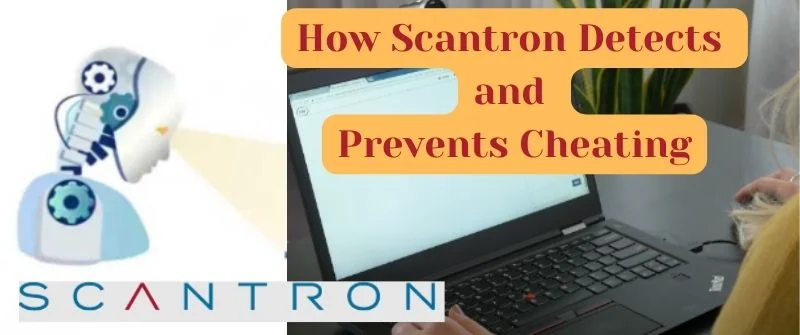
How Scantron Detects Cheating
Scantron Cheating: How it Detects Cheating and Tricks Students Use

Titles for Essay about Yourself
Good Titles for Essays about yourself: 31 Personal Essay Topics
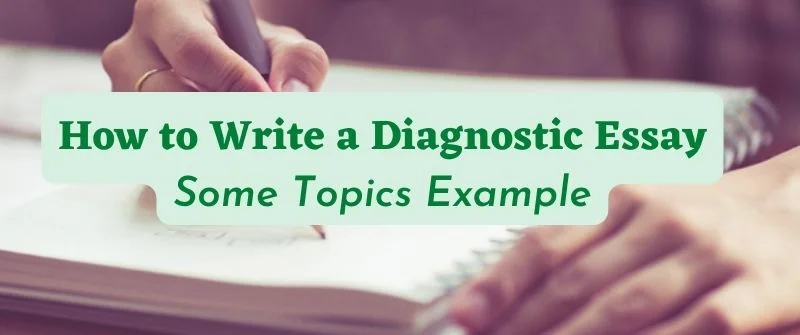
How to Write a Diagnostic Essay
How to Write a Diagnostic Essay: Meaning and Topics Example
- Academic writing
- Commonly confused words
- Critical thinking
PEEL Paragraphs
- Linking/transition words
- Paraphrasing
- Proofreading
- Terms and definitions
- Action Words: What is description, application, analysis and evaluation
What is meant by 'Link'?
In this case, it's not a web link that is required, but a suggestion in the text about either what you are going to analyse next or relating a point to the overall topic. If the link is at the end of the paragraph, it leads your reader easily to the next point.
For example:
X is not the only potential solution to this problem.
The link between X and [main topic] is clear, which demonstrates ...
Links help your reader to identify the logical order you are using to structure your written work.
Attend a workshop
Find out more about the Library and Academic Skills workshop programme here .
Academic writing can feel tricky sometimes; having to include all the information required and to analyse it fully. One writing tool which can be used to make sure you are hitting all your requirements is a PEEL paragraph.
PEEL stands for Point, Evidence, Explanation, Link.
When writing a paragraph ask yourself, does it PEEL?
- POINT - Make and introduce the reader to your point.
- EVIDENCE - Back it up, support the point you are making with examples or evidence. Typically with academic sources such as textbooks, journals or specialist products.
- EXPLANATION - Explain how the evidence or examples support your point. Critically analyse what would happen if the theory was or was not applied. Explain: why? how? what is the impact? for each point.
- LINK - Link this point to the next point that you will be making in the following paragraph, or link it back to the main point.
Once you have perfected the PEEL paragraph, add a C to make a PEELC paragraph!
PEELC stands for Point, Evidence, Explanation, Link, Critical Point
Apply your critical thinking skills to the literature / evidence you have used and make a point about it. This does not necessarily need to be at the end of the paragraph.
Some ideas of critical points you can make:
- comment on how recently research was carried out
- consider the methods that were used in research
- point out limitations to the research
- identify barriers to implementing recommendations made by the researchers
See the Critical Thinking guide to see how you can develop this skill.
For more information on assignment types, check out the Types of Assignments Library guide!
Paragraph length
How long should a paragraph be?
There's no definite answer to this - it depends a lot on your subject, the topic and your own writing style.
Be aware that:
- Paragraphs that are short (one, two or three sentences long, for example) are unlikely to provide the analysis and critical points required and can make your work 'clunky' to read.
- Paragraphs that are too long can be hard to follow as they can overload the reader with information.
Whatever the size, you should aim for your paragraphs to all be about the same size across the whole piece of work which will make your writing easier to read. As with many things related to academic skills, consistency is key!
Following the PEEL model can help you to avoid these issues!
- << Previous: Critical thinking
- Next: Linking/transition words >>
- Last Updated: Nov 8, 2024 10:38 AM
- URL: https://libguides.staffs.ac.uk/academic_writing
- Library and Learning Services, University of Staffordshire, College Road, Stoke-on-Trent, ST4 2DE
- Accessibility
- Library Regulations
- Appointments
- Library Search

- NCC Blog Home
Ultimate Guide to PEEL Paragraphs
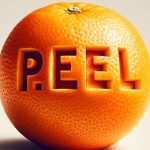
Peel paragraphs are largely associated with essay writing, and teachers today are keen to integrate these learning methods into school, college, and even university students to ensure that they know how to formulate essay paragraphs correctly. In this article, you will find the ultimate guide to P.E.E.L. paragraphs, explaining what it stands for, and how you can properly structure your essays around this format so that you can get your best achievable grade.
What is a PEEL Paragraph?
E = evidence/example:, e = explain:, practicing peel paragraphs:, adopt the ultimate p.e.e.l. paragraph method, faq’s.
P.E.E.L. is more than just an acronym; it’s a mnemonic device that can transform your writing abilities. This method can help those to better structure paragraphs to be centred on a single compelling argument.
What does PEEL stand for?
Let’s break down P.E.E.L. and by understanding what each letter stands for will help you to structure your essay arguments professionally so that you can follow your argument better as well as your assessor.
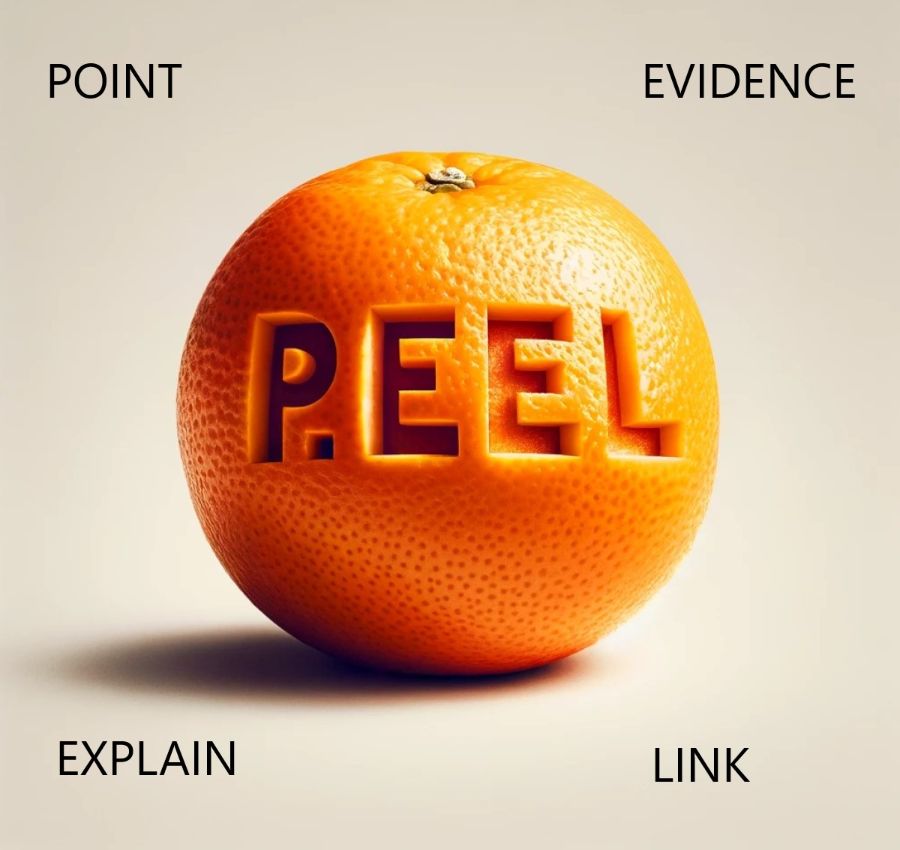
Every argument has to begin with a Point. Start your first paragraph with a robust topic sentence that sets the stage for your argument. Your Point should align seamlessly with your essay’s overarching thesis or argument.
For instance, consider this example: “Fast food advertising plays a significant role in contributing to childhood obesity rates.” This also acts as a hook to catch your readers’ attention. At the same time, this hook, or point, should not be overly long; keep it simple and to the point . Doing it this way will make it easier for you to follow and will ensure that you are not juggling too many balls at once when constructing your argument.

The Evidence/Example will build further upon your initial Point, adding more substance into the mix. Here, you will need one or more pieces of evidence to justify your point.
Your Example can take various forms—a quote, an image, a gripping film scene, and more. Choose an example that will particularly stand out, ones that your peers may not have thought of.
But don’t let your Example hang in isolation; provide context. A brief sentence or a few words about the broader plot or context behind the quote elevates your engagement with the text.
Consider this Example: a study published in the American Journal of Pediatrics found that children exposed to frequent fast food advertising on television were more likely to consume high-calorie, low-nutrient foods, leading to weight gain and increased risks of childhood obesity.
As you can see, this example follows the “Point” in the first paragraph. It provides concrete evidence to support the point made in the paragraph’s opening sentence. The evidence is specific and refers to a study published in a reputable journal, demonstrating how exposure to fast food advertising can lead to poor dietary choices among children, ultimately contributing to childhood obesity. This evidence strengthens the argument presented in the paragraph.
Delve deeper into literary analysis with our comprehensive English Literature course
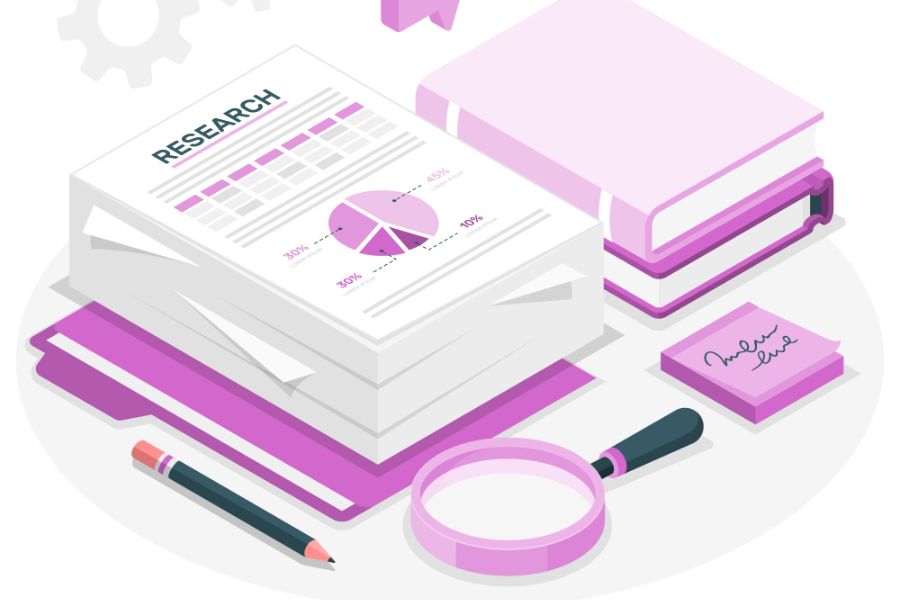
Now that we’ve presented our Example, it’s time to learn about the second “E” of PEEL paragraphs —Explain. This is where your analysis is important towards defining your overall argument, as to why you chose that particular example, and how it relates more to your point and example. Many people here may be tempted to reiterate what was said in the original point; however, you need to provide more unique evidence and explain more of your argument that, so far, has been unsaid.
Following on from the example about fast food, here is an explanation that adds more detail to that argument: Constant exposure to fast food ads creates a sense of desire among children, leading to a higher consumption of unhealthy foods, which adds to the increased risk of obesity-related health issues.
This Explanation serves the purpose of PEEL paragraphs by offering a thorough understanding of how the Example reinforces the original Point. However, in your argument, you may need to provide one or more paragraphs in your explanation depending on how detailed that you want your argument to be. So long as you structure your argument evenly, and do not lose sight of the overall narrative, you are offering further insights into your argument without losing the attention or confusing the reader.

As we draw this P.E.E.L. paragraph explanation to a close, it’s time to address the final letter—L, which stands for Link. This critical step ensures your paragraph cohesively ties together and, more importantly, links back to your essay’s central question, topic, or thesis.
The Link serves to wrap up your argument, making it clear and organised. However, it’s important to remember that the Link shouldn’t be a repetition of your Point; it should conclude your argument evenly without repeating what has already been said.
Here is an example of a Link to our argument: To conclude, the evidence suggests that fast food advertising indeed plays a significant role in shaping the dietary habits of children, ultimately contributing to the concerning rise in childhood obesity rates. Our initial Point , which highlighted the impact of fast food advertising, is now reinforced by the concrete Example of the study from the American Journal of Pediatrics. Through the Explanation , we uncovered the intricate mechanisms at play, solidifying the connection between advertising exposure and unhealthy food choices.
This Link encapsulates the essence of PEEL paragraphs by summarising the Point, demonstrating how the Example supports it, and reiterating the importance of this relationship. Whilst we added the ‘Point,’ ‘Example,’ and ‘Explanation’ within this text, this was merely as reference to you to easily follow this argument, and how you should initially format it when it comes to writing your assessment.

Learn P.E.E.L and much more
Improve your speaking, writing, or comprehension, we have the perfect course for you
Let’s put the PEEL structure into practice with a fresh example:
Topic: Should public transportation be free in metropolitan areas?
Thesis/Argument: Public transportation should be made free in metropolitan areas to reduce traffic congestion and promote environmental sustainability.
Point : Public transportation in metropolitan areas should be provided for free as it can alleviate traffic congestion and reduce the environmental footprint caused by excessive car usage.
Evidence/Example : A recent study conducted in major metropolitan cities across the world, including New York and London, demonstrated that when public transportation was made free during designated hours, there was a noticeable decrease in traffic congestion during those times. The study’s data revealed a 20% reduction in traffic volume during the morning and evening rush hours.
Explanation : The reason behind this reduction in traffic congestion is clear. When individuals are offered a convenient and cost-free alternative to driving their own vehicles, they are more likely to choose public transportation. This not only eases the burden on roads but also diminishes the emissions from numerous vehicles, contributing to a greener and more sustainable urban environment.
Link : In summation, this example underscores the potential benefits of making public transportation free during peak hours in metropolitan areas. It aligns with the broader argument that free public transportation can lead to reduced traffic congestion and a more eco-friendly urban landscape. As we explore the practical application of the P.E.E.L structure, it becomes evident that this method equips us with a powerful tool for crafting persuasive essays.
Each element – Point, Evidence/Example, Explanation, and Link – plays a distinct role in advancing your argument. And don’t forget the importance of proofreading to ensure your paragraph flows smoothly, to truly convey your message effectively.
And if you are having problems with your writing, here is how you can understand the four main writing styles .
And that is how you can use the PEEL paragraph method for your essay. From understanding its mnemonic origin to breaking down each component—Point, Evidence/Example, Explanation, and Link—we’ve equipped you with the skills to craft compelling paragraphs. Whether you’re an English High-Level Teaching Assistant (HLTA) aspirant or a student aiming to elevate your writing, the P.E.E.L. method offers a roadmap to clarity, coherence, and persuasive prowess in your essays.
Having this knowledge will be especially helpful for those learning about becoming a teaching assistant .
To include evidence in PEEL paragraphs, select relevant and compelling examples or data that support your point. Ensure the evidence is well-contextualised and directly related to your argument.
Teaching P.E.E.L. writing involves explaining each element (Point, Evidence/Example, Explanation, Link), providing examples, and practicing together. Encourage students to apply the structure in their writing assignments to enhance their skills.
Related articles
Career change for teachers: how to use your skills for new horizons.

What is Classroom Management: Strategies and Skills to Learn

What is a Foundation Degree: The Complete Guide

Help and advice
Related courses you may also like.
+1-559-742-0021
Tips And Ways For PEEL Paragraph Format
by Kayleen Lares | Dec 8, 2023 | Student Guide | 0 comments
Compelling arguments begin with a proper structure. The PEEL paragraph framework makes writing crisp, focused, and persuasive. This powerful technique grabs the reader’s attention with its acronym-based structure. PEEL anchor chart stands for Point, Evidence/Example, Explanation, and Link. In the following, we will emphasize each fact for ease of understanding and support your point. It is a complete guide for PEEL paragraph writing. Following are some explanations of PEEL. It can also be known as the acronym PEEL. Each element strengthens the overall message conveyance and embeds logic into the flow.
In this blog, we will discuss the peel paragraph and explore:
– How does the PEEL model streamline the writing process into an elegant four-step system?
– Why is it essential to use the PEEL paragraph?
– Trending PEEL paragraph examples.
– Several ways to conclude PEEL paragraphs in academic writing.
Table of Contents
How To Write A PEEL Paragraph: Tips And Checklist
Using the PEEL method of writing strategy enhances your ability to express key points concisely. Here’s a step-by-step guide to help you utilize this practical writing approach:
Step 1: Grasp the PEEL paragraph structure:
Understand the PEEL acronym:
Step 2: Formulate Your Key Point (P):
Identify the central idea you want to convey. Be clear and concise. Your crucial Point sets the tone for the entire paragraph they’re about to read.
Step 3: Provide Explanation (E1):
You may need to explain the Point to your tutor. Go beyond just stating the point. Explain what you mean in more detail. This can involve defining terms, giving background information, or describing a process or concept.
Step 4: Introduce & Analyze The Evidence (E2):
Support your crucial point with relevant evidence. Choose evidence that strongly aligns with your central idea, whether it’s a quote, statistic, or example. Don’t just present evidence; analyze it. Explain how the evidence supports your crucial point. This step adds depth to your paragraph.
Step 5: Link to the Next Point (L):
Wrap up your paragraph by connecting it to the next one. This ensures a smooth flow and coherence in your overall paragraph writing.
Get A Free Quote
Why Is PEEL Writing Essential?
You’re writing a PEEL paragraph for some positive outcome. Following are some of the reasons why PEEL paragraph writing approach can be of great benefit:
- Structure and Organization: The PEEL technique provides clear structure and organization to writing. The “Point-Explanation-Evidence-Link” format helps writers express their reasoning and arguments in an orderly, coherent way that is easy for readers to follow. This clarity of thought and logic is critical for effective writing.
- Persuasive and Convincing: By methodically building an argument with Explanation, Evidence, and linkage, PEEL paragraphs enable writers to persuade and convince readers of particular viewpoints. The credibility of factual evidence and the flow of logic make writing more compelling. The PEEL model equips writers with core persuasive techniques to influence audience opinions.
- Develops Critical Thinking: The steps of PEEL – Point, Explanation, Evidence, and linkage – promote critical thinking and analysis. Writers must evaluate information, distill key points, provide thoughtful interpretation, and synthesize new insights. This strengthens abilities in reasoning, research, and developing balanced perspectives.
- Assessment Ready: Many standardized tests and academic assignments mandate the PEEL writing structure. It enables evaluators to systematically assess aspects like argumentation, use of Evidence, analysis, and conclusions. Following PEEL means writing ready for academic and professional assessment.
- Flexibility: While ideal for developing individual paragraphs, the PEEL writing technique can be effectively applied in longer pieces of writing as well – such as essays, reports, literature reviews, etc. For example, each critical section or chapter can follow a PEEL format.
Thus, PEEL writing equips writers with an invaluable skill set that enables structured, logical, and convincing writing. It promotes abilities essential in academics, the workplace, public policy, scientific research, and more. That is why learning PEEL writing is tremendously helpful for any career path. Watch this YouTube video to know more!
Chat With Us
What Are The Several Ways To Conclude A PEEL Paragraph?
We also need to know several ways to conclude a PEEL paragraph thesis statement and the opening paragraph. Let’s explore the variety of conclusions as follows:
1. Link back to the main point/topic sentence: End by reinforcing the critical point or argument you made in the opening sentence. For example: “In conclusion, single-use plastics are devastatingly impacting oceans and wildlife.” This reminds the reader of the main topic.
2. Call to action: Close with a statement urging change or action to address the issue discussed. For example: “Governments need to implement policies now to curb plastic waste drastically.” This drives home the importance of tackling the problem.
3. Prediction: Predict to highlight future implications if the current situation continues or changes are not made. For example: “Without intervention to reduce overuse of social media, an entire generation faces chronic mental health issues like anxiety, isolation and depression.”
4. Personal opinion/commentary: Add a sentence or two sharing your views or thoughts on the central topic/issue. This adds a more conversational, authentic tone. For example, “Social media platforms are responsible for prioritizing user safety and wellbeing over profits and growth.”
5. Question: End with an open-ended question to spark further thought and discussion. For example, “How can we ensure social media has positive impacts while limiting harm to vulnerable young users?”
Example Of A PEEL Paragraph:
We have provided a PEEL paragraph worksheet sample in the following section to give students a practical idea about PEEL paragraphs . However, let us dig deeper to understand the concept with a trending example.
Let’s say our topic is “Artificial intelligence’s potential benefits.” Focus on how the content is distributed among these four sections in the paragraph in PEEL structure.
Topic: Artificial intelligence’s potential benefits
- Point: Artificial intelligence (AI) has the potential to revolutionize various industries and improve our daily lives.
- Example: In healthcare, AI-powered algorithms can analyze medical images with high accuracy, aiding in early disease detection and personalized treatment plans.
- Explain: AI can also automate repetitive tasks, freeing human resources for more creative and strategic endeavors. Furthermore, AI-powered chatbots can provide 24/7 customer service and support, enhancing customer satisfaction.
- Link: Overall, AI holds immense promise for progress across various fields, but ethical considerations and responsible development are crucial to ensure its positive impact.
The Bottom Line
Paragraphs should be clear, focused, and manageable. If your paragraph is getting too long, learn how to split it into multiple paragraphs and create a new paragraph for each new idea you bring to your essay. Finally, it’s crucial to always proofread your paragraphs. Read it once, twice, and again. Check paragraph spelling, grammar, language, and sentence flow. The most efficient way for this is to have yourself read aloud. If it sounds clunky or unclear, consider rewriting it. That’s it! This helps explain the PEEL method and how it will help you write your following essay. Remember all four points of PEEL writing skills and follow these correctly in every paragraph you write.
Contact Our Expert Now
Frequently Asked Questions
What is a peel paragraph.
A PEEL structure paragraph refers to the standard format for writing essays. It helps in focusing on a single and clear argument in a paragraph.
Students can easily construct paragraphs for school homework following this strategy. It allows them to create an essay that is easily accessible for the readers to understand.
How Do You Start A Good PEEL Paragraph?
Start with the main idea you will emphasize in the following section. PEEL paragraph sentence starters focus on engaging the viewers with a persuasive approach. Hence, start with a common question related to your topic or a statement in the opening sentence you will explain in the following section.
How Many Sentences Are In A PEEL Paragraph?
The PEEL structure has four main components. But there are no limitations as you can only use single sentences to describe each Point. If your main Point becomes too long, you can break it into two sentences for better flow and readability. Hence, PEEL paragraphs usually contain 4 to 10 sentences.
How Do You Structure A PEEL Paragraph?
It would help to structure your PEEL writing based on the four sections. Start the paragraph with the main idea you will share in the following section. Then, present Evidence you have to establish your ideas. After that, explain your ideas in simple words and finish the paragraph with a closing statement. Also, select a link to the following paragraphs in the concluding section.
What Sentences Start A PEEL Paragraph?
In the PEEL paragraph, the starting sentence should start with the Point or Topic sentence. It should state the main Point students are trying to establish in their paragraph.
What Is The First Sentence In The Paragraph?
Ideally, the topic sentence is the first sentence of the paragraph. This sentence gives an overview of the entire Point of discussion written or talked about by the writer in the coming section.
How useful was this post?
Click on a star to rate it!
Average rating 5 / 5. Vote count: 5
No votes so far! Be the first to rate this post.
We are sorry that this post was not useful for you!
Let us improve this post!
Tell us how we can improve this post?
Read More Similar Articles
How To Get Hawkes Learning Answers: Get Some Tips And Guidance!
Tips On How To Cheat on WileyPLUS Assignments? Get The Best WileyPLUS Answers
Top 6 Points On How Edgenuity Answers Help Students With Personalized Learning?
Recent Posts
- Reliable IXL Answers: Expert Solutions for IXL Learning Challenges - October 31, 2024
- Can Moodle Detect Cheating? Get Complete Detail With Proof - October 4, 2024
- How To Cheat On A Test: 30+ Effective Cheating Hacks - September 27, 2024
Get Online Calculus Homework Help: Find the Best Tutor or Helper
Online calculus homework help has become essential for students struggling with the complexities of calculus. Understanding limitations and derivatives and mastering integrals and series can be very challenging. That's why many students seek expert Do My Calculus...
How To Cheat On WileyPLUS Assignments? Get The Best WileyPLUS Answers
The education sector has seen major disruptions since the launch of online education. Leveraging the power of the internet, many educational institutions allow students to attend lectures and complete a course without having to attend classes in person. WileyPLUS is...
How To Finish ALEKS Topics Fast: Get ALEKS Answers Easily
The moment students enroll in ALEKS and start working on the assignments, they aim to complete the course quickly and receive the certificate as soon as possible. Therefore, it is often seen that students search online for How to finish ALEKS topics fast and easy! So,...
How To Get MathXL Solutions: Can You Cheat Or Get Accurate MathXL Answers From Experts?
Cheating on online courses is nothing new, especially when it comes to mathematics. Students who enroll in MathXL find it challenging to solve the questions, so they look for quick solutions to achieve high grades. So, if you are interested in knowing how to get...
Find Accurate WeBWork Answers For How To Cheat On WeBWork Answers And Solutions
Do you wonder about how to cheat on WeBWork answers? Are you facing difficulties in finding the correct answers over the internet? We are here to answer these questions and help you with WeBWork. This will help you in knowing the ways to cheat on Webwork and get good...
Special Offers
Browse by category.
- Guide To Aleks (4)
- Guide to Apex (4)
- Guide to Aplia (2)
- Guide To Big Ideas Math (4)
- Guide To Canvas (2)
- Guide To Cengage (3)
- Guide To DeltaMath (3)
- Guide To Edmentum (5)
- Guide To Edulastic (1)
- Guide To Essay (1)
- Guide To Hawkes (3)
- Guide To Khan Academy (1)
- Guide To Mathematics (7)
- Guide To MathXL (4)
- Guide To Mcgraw Hill (4)
- Guide To MyITLab (2)
- Guide To MyMathLab (4)
- Guide To MyOpenMath (2)
- Guide To MyStatLab (2)
- Guide To Online Class (15)
- Guide to Online Exam (5)
- Guide To WebAssign (12)
- Guide To WebWork (3)
- Guide To WileyPlus (4)
- Guide To zyBooks (1)
- Student Guide (47)
Reliable IXL Answers: Expert Solutions for IXL Learning Challenges
Have you been clueless about where to get IXL answers online? Then your search ends here because TakeOnlineClassHelp is here to guide you with the IXL portal and help you get accurate IXL answers online. But before that, it is important to know about the IXL portal...
Can Moodle Detect Cheating? Get Complete Detail With Proof
Can Moodle detect cheating? The one-word answer to the above question is Yes. The popular learning management system Moodle has many features that enable instructors to detect and deter cheating. Whether it is about Moodle, inspecting element answers, or plagiarism...
How To Cheat On A Test: 30+ Effective Cheating Hacks
Cheating in exams is not a new concept. Over the years, students have developed and modified different ways to cheat. It requires advanced skills, so you don’t get caught in the test. So, if you want to know how to cheat on a test, read this blog. We have mentioned...
Can Socrative Detect Cheating? Get Some Proper Guide
Can socrative detect cheating? Every teacher who utilizes Socrative asks themselves this excellent question. That's a "yes" from us to you. The teachers can spot dishonest kids on Socrative. To be clear, the majority of students do not cheat.What Is...
The Amazing Guide On How To Cheat On Proctorio!
Are you curious to know how to cheat on Proctorio? Online proctored exams have become the norm, with educational institutes relying heavily on proctoring software. Proctorio, an exceptional online proctoring software, has become the new normal. Its primary objective...
WhatsApp us

IMAGES
VIDEO
COMMENTS
The PEEL paragraph method is a technique used in writing to help structure paragraphs in a way that presents a single clear and focused argument, which links back to the essay topic or thesis statement.
PEEL is a mnemonic (a pattern or word that can help us remember an idea or concept) used to organise your writing and ensure that you’re focussing on a single clear argument in each paragraph. This mnemonic stands for: Point, Example, Explain, Link.
A peel paragraph is a great way to end your essay on a high note, but that doesn’t mean you should just tack on a few extra words at the end and call it done. The idea behind a peel paragraph is that you want to draw attention to something specific in your opening or closing lines.
PEELC stands for Point, Evidence, Explanation, Link, Critical Point. Apply your critical thinking skills to the literature / evidence you have used and make a point about it. This does not necessarily need to be at the end of the paragraph. Some ideas of critical points you can make:
Learn to write clear, persuasive essay paragraphs using the PEEL method. Master structure, evidence, and explanations to boost your marks.
Adopt The Ultimate P.E.E.L. Paragraph Method. And that is how you can use the PEEL paragraph method for your essay. From understanding its mnemonic origin to breaking down each component—Point, Evidence/Example, Explanation, and Link—we’ve equipped you with the skills to craft compelling paragraphs.
How to write paragraphs using the PEEL Approach. Structuring paragraphs is often the best way to make a quick improvement to your writing. A good paragraph should have a clear main idea or topic, which is distinct from surrounding paragraphs, links to surrounding paragraphs and includes evidence and evaluation.
Description. PEEL Writing Method. 233 Likes. 19,589 Views. 2022 Jun 2. Chapters. Music 1 songs. Transcript. Follow along using the transcript. Amy Campbell. 57 subscribers. Transcript. How To...
The PEEL acronym is one way to effectively structure a paragraph in essay writing. Each paragraph you write is making a point about the stance or argument you are taking on a given subject that you are writing about, giving evidence to support that point, explaining and exploring it using critical
How To Write A PEEL Paragraph: Tips And Checklist. Using the PEEL method of writing strategy enhances your ability to express key points concisely. Here’s a step-by-step guide to help you utilize this practical writing approach: Step 1: Grasp the PEEL paragraph structure: Understand the PEEL acronym: P: Point.